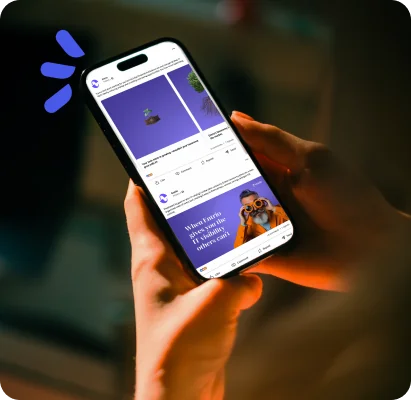
Marketing is harder than ever. Buyers are busier, the noise is louder, and attention spans are shorter. You can spend weeks perfecting a campaign—only to watch it fall flat because it didn’t reach the right people in the right way.
But here’s the truth: even the most creative ideas won’t work if they’re aimed at the wrong audience. It’s like throwing darts blindfolded—you might get lucky once in a while, but most of the time you’ll miss the mark.
That’s why buyer personas matter. They’re the foundation for every smart marketing strategy, helping you understand not just who your audience is, but what they actually care about.
Without personas, marketing is guesswork. With them, it’s a roadmap to results.
In this guide, we’ll cover what personas are, why they matter, and how to build them the right way (with plenty of practical tips and examples along the way).
What is a buyer persona?
At its simplest, a buyer persona is a fictional representation of your ideal customer. But don’t let the word fictional fool you. These profiles are built on real data, customer insights, and conversations. A good persona blends the facts (like company size, industry, and role) with the emotional drivers (like fear of wasting budget or pressure to hit quarterly goals) that influence buying decisions.
Instead of saying, “We target marketing managers,” a persona gives you this:
Casey, Content Manager
Casey works at a growing healthcare tech company. She’s focused on building brand trust and generating leads through thought leadership content. Her challenge? She’s stretched thin—juggling multiple priorities with limited time and resources.
Now you know more than her job title—you understand her goals, frustrations, and where you can help.
Why buyer personas matter
Campaigns succeed or fail based on how well you understand your audience. Without that clarity, marketing turns into a guessing game—messages feel generic, sales calls stall, and growth slows. With personas, your team knows exactly who you’re speaking to, what problems they’re solving, and how your solution fits into their world. That shared understanding builds alignment—and results.
Two companies launch the same campaign at the same time:
- Company A builds around well-researched buyer personas.
- Company B relies on gut instinct (great for a seasoned salesperson, but hard to translate to all team members!)
At first, the results look similar. But within a quarter, the gap is obvious:
| Company A The persona-driven company is booking qualified meetings, closing deals and refining messaging with confidence. | Company B The other is chasing unqualified leads, stuck in misalignment between sales and marketing, and struggling to explain why growth has stalled. |
We’ve seen both sides of the spectrum—and that’s exactly why we advocate for the former.
The numbers back it up:
- 71% of companies that exceed revenue and lead goals have documented personas compared to just 26% of those that miss them.
- Marketers who use personas to map content to the buyer’s journey see 73% higher conversions from response to MQLs.
Personas don’t just define your audience—they align marketing, sales, product and customer success around the same buyer. That alignment shows up in revenue, retention and long-term growth.
💡Tip: Don’t silo personas as a marketing project. The best results happen when every team uses them to guide decisions.
What happens if you skip buyer personas?
Skip personas, and the cracks show fast.
Campaigns launch, but you’re left wondering why they don’t connect. Sales says the leads aren’t qualified. Marketing points to clicks and claims the strategy is working. Product builds features no one asked for. Everyone is busy, but nobody’s moving in the same direction.
We’ve seen companies pour serious time and money into strategies like these—only to discover the problem wasn’t the campaign. It was the missing foundation. Without personas, teams operate on assumptions. And assumptions don’t close deals.
The fallout usually looks like this:
- Campaigns miss the mark because they’re speaking to everyone instead of someone.
- Sales and marketing chase different targets, creating frustration on both sides.
- Leads come in, but they don’t convert because they’re the wrong fit.
- Messaging stays vague, blending into the noise instead of breaking through.
💡Tip: If your campaigns keep underperforming, ask this first: Did we build this for a real persona—or for a vague idea of an audience? That simple check can save you from pouring more budget into the wrong direction.
How to build buyer personas (the Accelity way)
Building personas isn’t about filling out a worksheet—it’s about uncovering what truly drives your buyers.
At Accelity, we follow a process that blends client knowledge with outside research to make sure every persona is rooted in reality, not guessing.
1. Start with discovery workshops
We capture what your team already knows about your audience. These conversations surface the hypotheses that shape your strategy and pressure-test the assumptions behind it.
2. Validate with research
Internal input is a starting point. As Michael Ray, our Strategic Marketing Director, emphasizes, you need outside voices to build personas that actually work. That means customer interviews, surveys, third-party research and CRM data—not just what your team believes to be true.
3. Dig deeper than surface-level
Efficiency and cost savings are common answers. Stephanie Roland, our Strategic Brand & Marketing Director, challenges teams to go further: “If someone says ‘I want efficiency,’ ask what efficiency really means to them. Does it save time, reduce stress or help them earn credibility with leadership? That’s the difference between a shallow persona and a useful one.”
4. Document thoroughly
Strong personas capture demographics, psychographics, buying behavior and content preferences. Done right, they become tools marketing, sales and product can rely on—not files that collect dust.
5. Update regularly
Markets shift. Priorities change. The best companies revisit personas at least every six months to stay sharp and relevant.
💡 Tip: Start with 2–3 core personas that represent your highest-value buyers. You can expand later. What matters most is creating ones that your team will actually use.
What to include in a buyer persona
A strong persona is more than a name and job title—it’s a full story of who your buyer is and what drives their decisions. Here are the core elements to include:
- Demographics: Job title, company size, education, location
- Psychographics: Motivations, goals, challenges
- Story: Role, responsibilities, tools they use, communication styl.
- Buying behavior: Are they a decision-maker, influencer or blocker? What drives their choices?
- Content & communication: What they like to read, watch or listen to, and where they spend their time
Our strategist Stephanie reminds clients that this is where most teams fall short:
“Emotional and rational frustrations and barriers matter. What challenges do they experience in their role? What gets in the way of success—or keeps them up at night? Don’t just stop at, ‘They’re risk-averse.’ Push further: What’s preventing them from trusting your product or your category? Are there perceptions about your brand that need to be addressed?”
That’s how you move from surface-level profiles to personas that actually shape strategy.
💡Tip: Don’t just document what makes your buyers say “yes.” Spend equal time on what makes them hesitate or say “no.” Those insights are often the most valuable.
The right personas change everything
Strong personas are the difference between campaigns that connect and campaigns that fizzle. With them, you’ll create sharper messaging, have stronger sales conversations, and build smarter growth strategies.
Companies that invest in personas see clearer alignment, stronger pipelines, and more sustainable growth. The ones that don’t often end up stuck chasing the wrong audience or struggling to explain why results have stalled.Want help building buying personas that will transform your messaging? Let’s talk marketing services.
Subscribe to our newsletter
Curated content, news articles, team updates and more.



